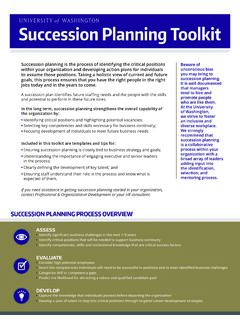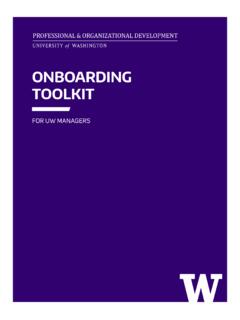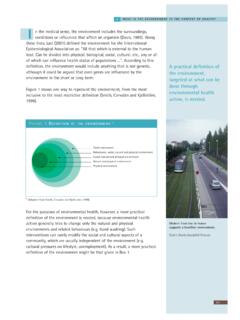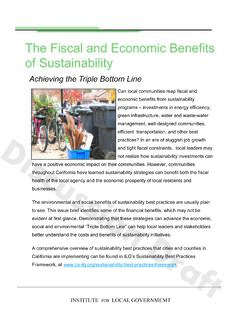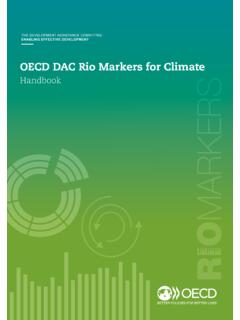Transcription of The Supervisor’s Role in Creating a Positive Work Environment
1 Workshop Handout: The Supervisor s Role in Creating a Positive Work Environment Provided by UW Human Resources Operations and UW Medicine Human Resources Special thanks to UW Medicine Organizational Development & Training page 1 Workshop: The Supervisor s Role in Creating a Positive Work Environment Supervisor s Influence - The relationship with a manager/supervisor is essential to employee satisfaction, engagement and performance. Supervisory Practices that Promote Positive Work Environments Self-Reflection Questions Yes I could practice or learn more Self-Awareness & Role Modeling Effective Communication & Performance Management Acknowledgement & Appreciation of Good Work 1.
2 Am I aware of my strengths and challenges as a leader? 2. Am I aware of the impact that my behavior has on others regardless of my good intent? 3. Do I communicate respectfully? 4. Do I role-model the behaviors I expect from others? 5. Do I respectfully address performance and behavior issues? 6. Do I regularly acknowledge good work and express appreciation? 7. Do I seek feedback and opportunities to develop my skills as a leader? Self-Awareness and Role-Modeling Practice behaviors you expect from others. Reflect on your strengths and challenges as a leader and identify areas where you can develop your abilities and skills further.
3 Seek feedback from others to learn more about how others perceive your actions. Remember: Intent versus Impact o Are your ever misunderstood? o Do others perceive your behavior in the way you want them to? Workshop Handout: The Supervisor s Role in Creating a Positive Work Environment Provided by UW Human Resources Operations and UW Medicine Human Resources Special thanks to UW Medicine Organizational Development & Training page 2 Effective Communication Use Dialogue Skills Suspend Assumptions Suspending assumptions means LISTENING to LEARN as you stay open-minded and holding off responding until the sender has completed the message.
4 Avoid making assumptions. Avoid preparing your response instead of LISTENING to LEARN. Avoid interrupting the other person. Ask questions and/or paraphrase to learn more and to clarify your understanding Seek first to understand, then to be understood. ~ Stephen Covey Respond as appropriate when it s your turn. Attribute Positive Intent Assume others have Positive intentions. Look for the most respectful interpretations of the person s behavior and intentions. Recognize that we have a choice in attributing intent. Balance Inquiry with Advocacy In your own communication style, observe to learn whether you tend to ask questions or make statements more.
5 Every conversation is different and not all lend themselves to a perfect balance of these two skills. However, crucial conversations DO require more inquiry than a regular conversation in order to reach a Positive result. Inquire (ask questions) in ways that make it safe to respond. Advocate (state your need/perspective) in ways that make it safe to share. Show Empathy and Respect Showing empathy requires being attuned to the other person s emotional state and understanding the position they are advocating (even if you don t agree with it). Pay attention to the person s emotional state.
6 Pay attention to the position they are taking and their reasons. Hold the person at a higher level of importance than the problem. Establish Mutual Purpose Find the common ground between you and the person with whom you are having a crucial conversation. Use inquiry skills to understand their position. What do they perceive as the purpose ? Make statements that indicate where you have common ground, even if that common ground is much larger in context than the issue you are discussing. Workshop Handout: The Supervisor s Role in Creating a Positive Work Environment Provided by UW Human Resources Operations and UW Medicine Human Resources Special thanks to UW Medicine Organizational Development & Training page 3 Effective Performance Management Role model expected behaviors and address issues promptly and respectfully.
7 Use the Conversation Model (see attached handout) for preparing for and facilitating respectful conversations when addressing issues. Performance Issue Examples Tardiness Not following procedures Making errors Late in completing assigned tasks Ineffective communication Behavior Issue Examples Behaving unprofessionally ( dress, language) Working ineffectively with co-workers Not being respectful of others Bullying others Defining and Recognizing Bullying In our society, we are becoming more aware of behaviors that constitute bullying. These behaviors are at times challenging to identify so here is some information to assist.
8 Bullying occurs at work when a person of group of people repeatedly behave(s) unreasonable towards a worker or a group of workers the target(s). A form of violence (usually verbal) Looks like two people in conflict, but these are not two people with equal power who simply hold different opinions. The targeted individual often feels unable or unwilling to respond reasonably to the perpetrator s aggressive behavior. Nonverbal cues coupled with verbal abuse and the tactics of exclusion are delivered by perpetrators repeatedly toward the targeted individuals.
9 There is no law in the against bullying. Potential Bullying Behaviors Examples Verbal abuse ( , being sworn at, being shouted at, being called demeaning names) Aggressive, intimidating, or threating conduct Blame without factual justification Excessive monitoring or micro-managing Being given unrealistic deadlines Belittling or humiliating comments Work interference (sabotage) Spreading malicious rumors Belittling or humiliating comments Teasing, practical jokes or initiation ceremonies Pressure to behave in an inappropriate manner Many Others Supervisor s Responsibilities regarding Bullying Supervisors are responsible for keeping their workplace free of bullying behaviors.
10 If supervisors are aware of potential bullying, they must take action to ensure it stops and does not start again. Supervisors should monitor their own behavior to ensure they are not perceived as bullying. Remember Intent vs Impact. Workshop Handout: The Supervisor s Role in Creating a Positive Work Environment Provided by UW Human Resources Operations and UW Medicine Human Resources Special thanks to UW Medicine Organizational Development & Training page 4 Acknowledgement & Appreciation of Good Work Let direct reports know when you observe them doing good work.

